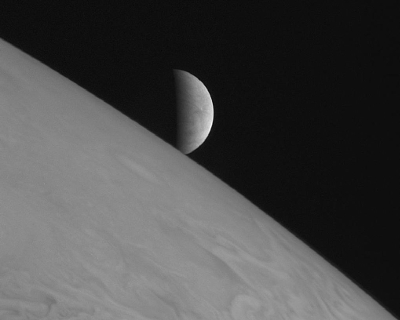Europa is an icy moon orbiting the planet Jupiter. It is the smallest of the four large moons of Jupiter, which are referred to as the Galilean satellites. Europa is slightly smaller than Earth’s moon. The same side of Europa always faces Jupiter. The moon orbits Jupiter in about three and a half Earth days. While it does have an oxygen atmosphere, it’s too thin for humans to breathe.
Europa is covered by an icy shell, due to its distance from the sun. However, data from the Galileo spacecraft, which explored the Jupiter system from 1995-2003, found strong evidence for a saltwater ocean surrounding the entire moon beneath its frozen crust. This ocean may hold twice the amount of water on Earth.

Scientists think that Europa’s irregularly-shaped orbit keeps the water fluid. When the moon’s journey brings it closer to Jupiter, the huge planet’s gravitational pull causes Europa’s solid surface to bulge toward it, similar to the way the Earth’s moon controls ocean tides. When farther away from Jupiter, Europa’s surface resumes a more spherical shape. This continuous flexing generates the heat that is thought to prevent the subsurface ocean from freezing. It probably causes the cracks seen on the moon’s surface, and may also drive volcanic activity.
The potential for both liquid water and volcanic activity on Europa make the moon one of the best places in the solar system to look for extraterrestrial life. Its ocean is believed to be in direct contact with a rocky sea floor (rather than sandwiched between two layers of ice, like on two of Jupiter’s other moons, Ganymede and Calisto).
This means that geologic activity could feed the ocean the energy, nutrients, and chemicals needed to support simple life forms.
This vast, cold ocean could be capable of harboring life similar to the organisms that live in “extreme,” inhospitable environments on Earth, such as hydrothermal vents, the interiors of hot rocks, and near-frozen polar lakes.
NASA plans to launch a spacecraft aimed for Jupiter in the 2020s. Upon its arrival several years later, the spacecraft would orbit the planet approximately every two weeks and conduct 45 flybys of Europa. The spacecraft would take high-resolution images of the frozen surface and analyze the moon’s composition.
Learn more about extremophiles, organisms that live in extreme environments on Earth.